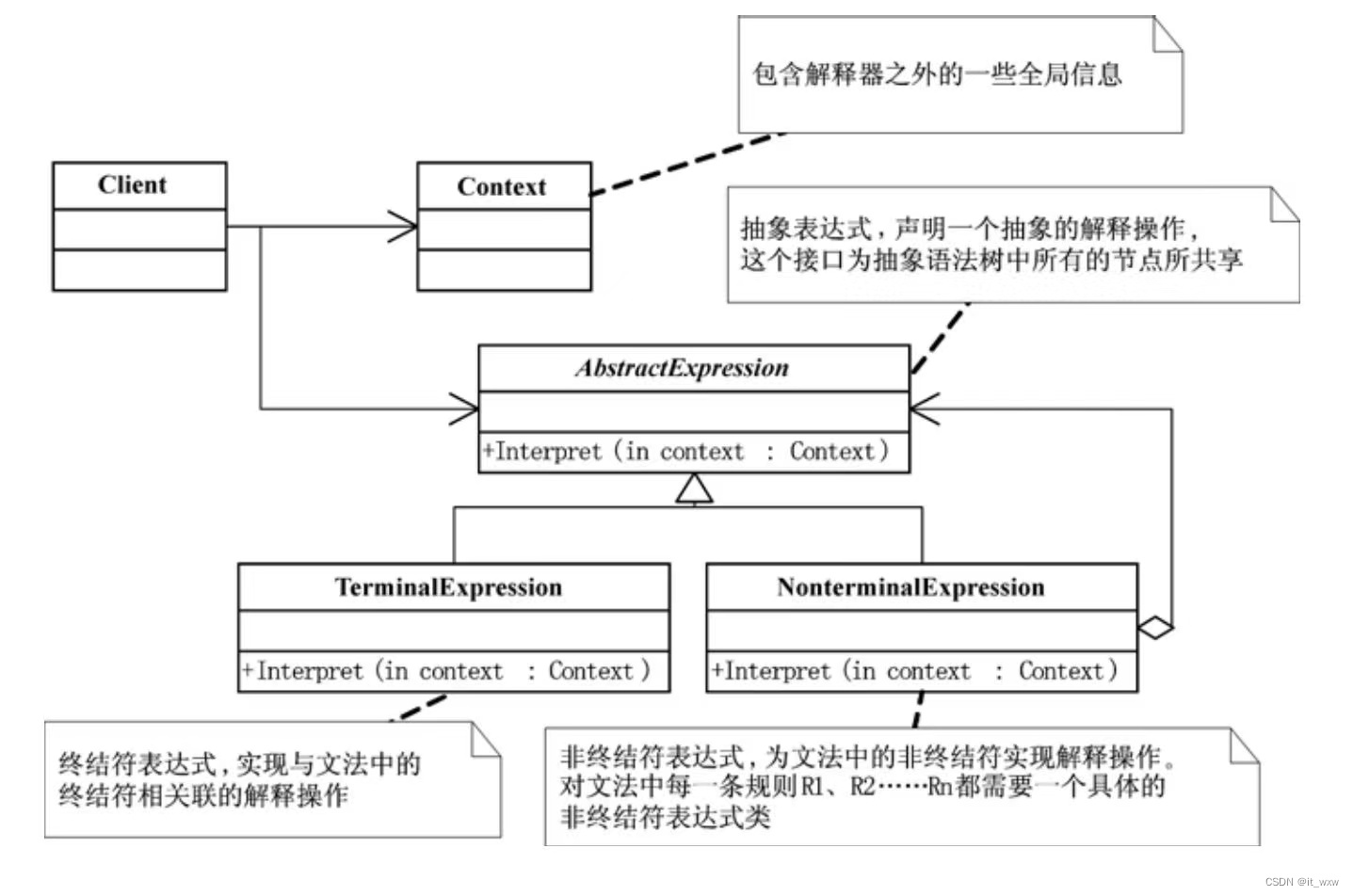解释器模式
说明
解释器模式(Interpreter Pattern)属于行为型模式,是指给定一门语言,定义它的语法(文法)的一种表示,并定义一个解释器,该解释器使用该表示来解释语言中的句子。是一种按照规定的语法(文法)对语言进行解析的模式。
我们平时开发用的编译器,就是一种解释器的实现,通过规定好的编程语法,通过解析后转换成机器码,才能让计算机执行。某些领域也有其规范的语法,比如乐谱、莫斯码等等。解释器模式在开发中几乎不会用到,除非需要创建一门新的语言。
结构
解释器模式主要角色如下:
抽象表达式(Expression):定义解释语法的接口;
终结符表达式(TerminalExpression):实现Expression定义的解释方法。终结符表达式可以理解为语法中需要被操作的对象,比如1 + 2,1跟2都是终结符表达式;
非终结符表达式(NonterminalExpression):实现Expression定义的解释方法。非终结符表达式可以理解为语法中的运算符或者关键字,根据需求有不同的实现;
上下文环境类(Context):包含解释器之外的信息与逻辑,负责根据语法调用不同的解释器等功能。

代码案例
抽象表达式(Expression)
/*** @program: interpreter* @description: 抽象表达式接口* @author: wxw* @create: 2024-03-13 18:33**/
public interface IExpression {String interpret();
}
非终结符表达式(NonterminalExpression)
/*** @program: interpreter* @description: 处理字符串表达式* 非终结符表达式(NonterminalExpression)* @author: wxw* @create: 2024-03-13 18:36**/
public abstract class ProcessingExpression implements IExpression {protected IExpression str;public ProcessingExpression(IExpression str) {this.str = str;}
}/*** @program: interpreter* @description: 转换大写-处理字符串表达式* 非终结符表达式(NonterminalExpression)* @author: wxw* @create: 2024-03-13 18:44**/
public class UppercaseExpression extends ProcessingExpression {public UppercaseExpression(IExpression str) {super(str);}@Overridepublic String interpret() {return str.interpret().toUpperCase();}
}/*** @program: interpreter* @description: 转换小写-处理字符串表达式* 非终结符表达式(NonterminalExpression)* @author: wxw* @create: 2024-03-13 18:44**/
public class LowercaseExpression extends ProcessingExpression {public LowercaseExpression(IExpression str) {super(str);}@Overridepublic String interpret() {return str.interpret().toLowerCase();}
}/*** @program: interpreter* @description: 转换成char数组-处理字符串表达式* 非终结符表达式(NonterminalExpression)* @author: wxw* @create: 2024-03-13 18:44**/
public class CharsExpression extends ProcessingExpression {public CharsExpression(IExpression str) {super(str);}@Overridepublic String interpret() {return Arrays.toString(str.interpret().toCharArray());}
}
终结符表达式(TerminalExpression)
/*** @program: interpreter* @description: 字符串终结表达式* 终结符表达式(TerminalExpression)* @author: wxw* @create: 2024-03-13 18:35**/
public class StringExpression implements IExpression {private String str;public StringExpression(String str) {this.str = str;}@Overridepublic String interpret() {return this.str;}
}
上下文环境类
/*** @program: interpreter* @description: 上下文环境类* @author: wxw* @create: 2024-03-13 18:38**/
public class StringContext {private String str;public StringContext(String str) {this.str = str;}public String handleStr(){String[] strs = str.split(" ");String key = strs[0];IExpression str = new StringExpression(strs[1]);switch (key){case "uppercase":return new UppercaseExpression(str).interpret();case "lowercase":return new LowercaseExpression(str).interpret();case "chars":return new CharsExpression(str).interpret();default:return "输入错误!!!";}}
}
客户端
public class Test {public static void main(String[] args) {String str1 = "uppercase hello!!!";String str2 = "lowercase Hello!!!";String str3 = "chars hello!!!";StringContext stringContext1 = new StringContext(str1);System.out.println(stringContext1.handleStr());StringContext stringContext2 = new StringContext(str2);System.out.println(stringContext2.handleStr());StringContext stringContext3 = new StringContext(str3);System.out.println(stringContext3.handleStr());}
}
输出结果
HELLO!!!
hello!!!
[h, e, l, l, o, !, !, !]
![[NSSRound#18 Basic]web解析](http://pic.xiahunao.cn/[NSSRound#18 Basic]web解析)

![Exam in MAC [容斥]](http://pic.xiahunao.cn/Exam in MAC [容斥])




)


)





)


函数解析)